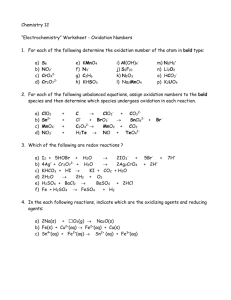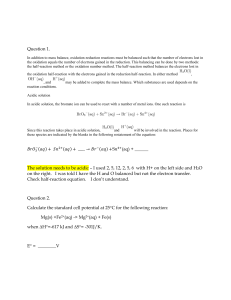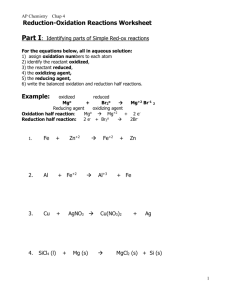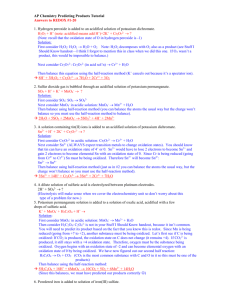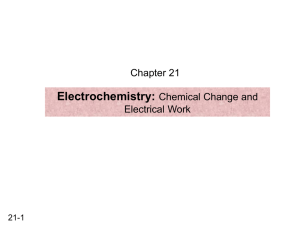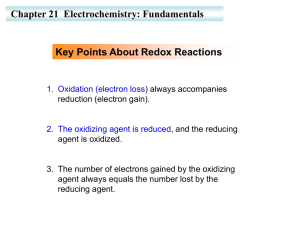CH 117 Spring 2015Worksheet 19 Chapter 16 Define each of the
advertisement
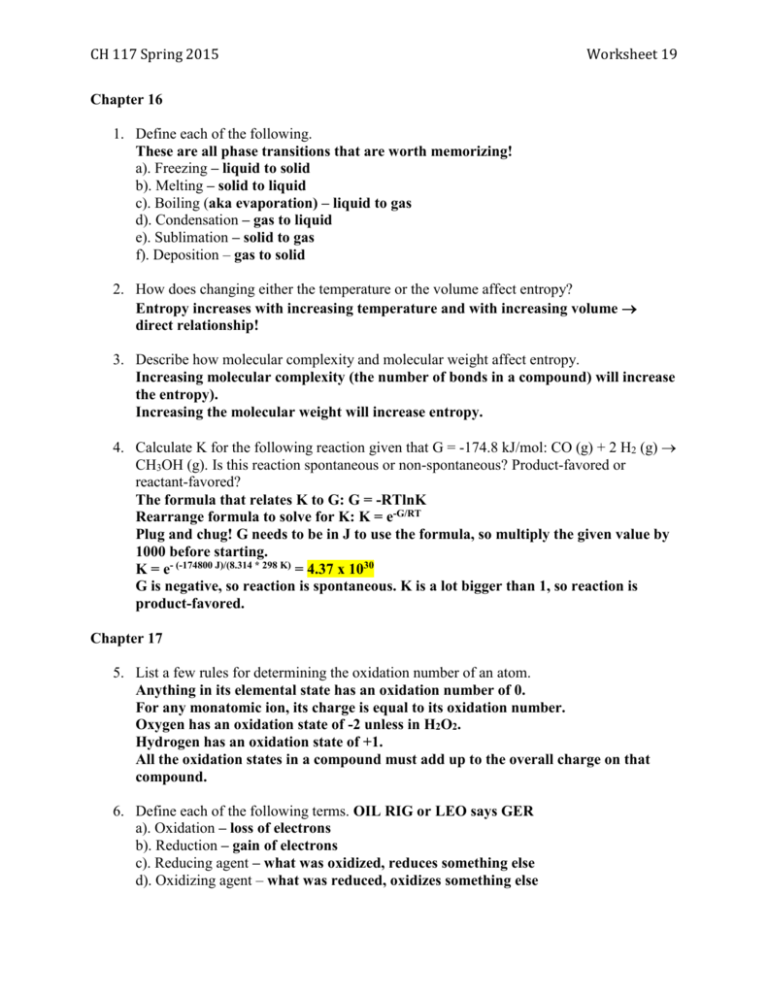
CH 117 Spring 2015 Worksheet 19 Chapter 16 1. Define each of the following. These are all phase transitions that are worth memorizing! a). Freezing – liquid to solid b). Melting – solid to liquid c). Boiling (aka evaporation) – liquid to gas d). Condensation – gas to liquid e). Sublimation – solid to gas f). Deposition – gas to solid 2. How does changing either the temperature or the volume affect entropy? Entropy increases with increasing temperature and with increasing volume direct relationship! 3. Describe how molecular complexity and molecular weight affect entropy. Increasing molecular complexity (the number of bonds in a compound) will increase the entropy). Increasing the molecular weight will increase entropy. 4. Calculate K for the following reaction given that G = -174.8 kJ/mol: CO (g) + 2 H2 (g) CH3OH (g). Is this reaction spontaneous or non-spontaneous? Product-favored or reactant-favored? The formula that relates K to G: G = -RTlnK Rearrange formula to solve for K: K = e-G/RT Plug and chug! G needs to be in J to use the formula, so multiply the given value by 1000 before starting. K = e- (-174800 J)/(8.314 * 298 K) = 4.37 x 1030 G is negative, so reaction is spontaneous. K is a lot bigger than 1, so reaction is product-favored. Chapter 17 5. List a few rules for determining the oxidation number of an atom. Anything in its elemental state has an oxidation number of 0. For any monatomic ion, its charge is equal to its oxidation number. Oxygen has an oxidation state of -2 unless in H2O2. Hydrogen has an oxidation state of +1. All the oxidation states in a compound must add up to the overall charge on that compound. 6. Define each of the following terms. OIL RIG or LEO says GER a). Oxidation – loss of electrons b). Reduction – gain of electrons c). Reducing agent – what was oxidized, reduces something else d). Oxidizing agent – what was reduced, oxidizes something else CH 117 Spring 2015 Worksheet 19 7. Identify which element was oxidized, which was reduced, the reducing and oxidizing agents, and the half-reaction for the following. a). 2 Cr+ + Sn4+ Cr3+ + Sn2+ First step is to assign oxidation states to all elements. Cr+: +1 Sn4+: +4 Cr3+: +3 Sn2+: +2 Cr+ is oxidized (lost electrons) acts as reducing agent Sn4+ is reduced (gained electrons) acts as oxidizing agent Oxidation half-reaction: Cr+ Cr3+ + 2eReduction half-reaction: Sn4+ + 2e- Sn2+ b). 3 Hg2+ + 2 Fe (s) 3 Hg2 + 2 Fe3+ 2+ Hg : +2 Fe (s): 0 Hg2: 0 Fe3+: +3 Hg2+ is reduced acts as oxidizing agent Fe (s) is oxidized acts as reducing agent Oxidation half-reaction: 2 Fe (s) 2 Fe3+ + 6eReduction half-reaction: 3 Hg2+ + 6e- 3 Hg2 c). 2 As (s) + 3 Cl2 (g) 2 AsCl3 As (s): 0 Cl2 (g): 0 As in AsCl3: +3 Cl in AsCl3: -1 As (s) is oxidized acts as reducing agent Cl2 (g) is reduced acts as oxidizing agent Oxidation half-reaction: 2 As (s) 2 As3+ + 6eReduction half-reaction: 3 Cl2 (g) + 6e- 6 Cl8. Distinguish between an electrolytic and a voltaic or galvanic cell. An electrolytic cell is one that is nonspontaneous needs the addition of electricity to make the reaction go forward, G is positive, Ecell is negative. A voltaic/galvanic cell is one that occurs spontaneously without the input of electricity, G is negative, Ecell is positive. 9. Draw a typical galvanic cell using the following half-reactions and cell potentials. Write the overall reaction, calculate the Ecell for the reaction, and label all of the necessary parts of the cell. Al3+ + 3e- Al (s) E = -1.66 oxidation Pb2+ + 2e- Pb (s) E = -0.36 reduction CH 117 Spring 2015 Worksheet 19 To write the overall reaction the number of electrons must be balanced and cancel each other out. We have to multiply the top reaction by 2 and the bottom one by 3 for this to happen. We also need to flip the first reaction around since it is given as a reduction but will only occur as an oxidation. 2 Al (s) 2 Al3+ + 6e- E = 1.66 3 Pb2+ + 6e- 3 Pb (s) E = -0.36 Now, add the two half-reactions together to get the overall reaction: 2 Al (s) + 3 Pb2+ 2 Al3+ + 3 Pb (s) Ecell = Eox + Ered = 1.66 – 0.36 = 1.30 V

